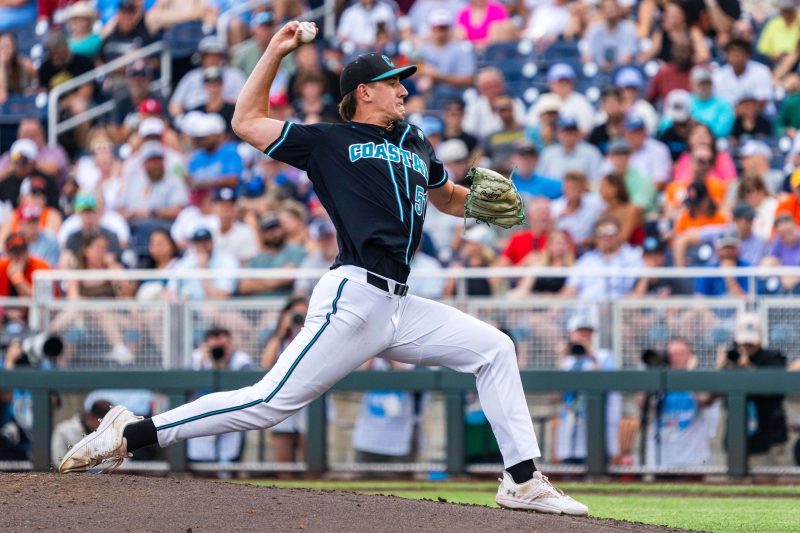
- Coastal Carolina’s pitching staff, ranked second nationally in ERA, is a key factor in its success.
- Most of Coastal Carolina’s pitchers are homegrown talents who have shown significant improvement this season.
- The team’s new pitching coach, Matt Williams, and catcher Caden Bodine have played crucial roles in the pitching staff’s development.
OMAHA, NE ― Jacob Morrison walked off the mound at Charles Schwab Field to a rousing standing ovation.
The Coastal Carolina starting pitcher had just finished pitching 7⅔ scoreless innings. He didn’t walk anyone and struck out seven. Four outs from the bullpen later, the Chanticleers had clinched their spot in the College World Series semifinals, where they will take on Louisville on June 18 needing one win to play for a championship.
Morrison, the Sun Belt pitcher of the year, has a perfect 12-0 record this season with a 2.08 ERA. But Coastal Carolina coach Kevin Schnall didn’t choose him to start him in its CWS opener − the Chanticleers didn’t need to.
Instead, Schnall went with a combination of Riley Eikhoff, who is 6-2 with a 2.98 ERA, and Cameron Flukey, who is 7-1 with a 3.29 ERA. Coastal Carolina won that game against Arizona.
Armed with a pitching staff that ranks second nationally in ERA, the Chanticleers are now in the driver’s seat to advance to the College World Series finals for the first time since their 2016 national title run.
‘I think we can continue to be the best pitching staff in Omaha,’ Eikhoff told USA TODAY Sports after the win over Oregon State.
Perhaps even more impressive than Coastal Carolina’s pitching success is how it happened. There aren’t any big-name transfers among the group. Nine of the Chanticleers’ 10 most used pitchers began their college careers with Coastal; the one who didn’t, closer Ryan Lynch, started at a junior college. The group is also relatively young, including two freshmen and three sophomores.
The 2024 Chanticleers were in their final season under longtime coach Gary Gilmore. They were one of the last four teams to receive an at-large bid to the NCAA tournament. When Schnall, who was assistant under Gilmore since 2016, took over before this season, the team was picked to finish fourth in the Sun Belt.
A big reason why Coastal Carolina exceeded those expectations − winning the Sun Belt regular season and tournament titles and riding a 25-game win streak − was across-the-board improvement of the Chanticleers’ returning pitchers. Many of those arms credit the success to the hire of pitching coach Matt Williams, who spent the 2024 season at South Carolina, as well as to the impact of catcher Caden Bodine, who is considered one of the top defensive catchers in the country.
‘Pounding the zone has been a huge part,’ Lynch said. ‘All of our starters are very efficient. Get early strikes, pound the zone, try to limit walks, then just having our defense behind us. … And then having (Bodine) behind the plate, just him getting pitches that would be off the plate or low that he’s getting strikes for us.’
Coastal Carolina’s 8% walk rate is the lowest among teams in Omaha and fifth-lowest of all Division I teams in 2025. But while low walk rates are often associated with a lack of high-octane stuff, that’s not the case for the Chanticleers, either. Morrison, whose fastball touches 95 mph at 6-foot-8, was ranked the No. 181 MLB draft prospect for 2025 by MLB Pipeline. Flukey, whose velocity has been up to 98 mph, is considered a top-three rounds prospect for the 2026 draft. Lefty reliever Dominick Carbone has a nasty slider.
For Morrison, a big part of his development was working through Tommy John surgery rehab. He had a 6.55 ERA in 13 starts as a freshman in 2023 but missed the entire 2024 season with injury.
‘I’ve always been a big strike thrower,’ Morrison said in the press conference after the Oregon State game. ‘My freshman year, I threw a ton of strikes but I had a hard time keeping the ball out of the middle of the plate. That was a big thing, not only in my rehab last year, but even in freshman year development, throwing pitches where I want.’
Flukey, a sophomore who had a 5.73 ERA in 19 appearances as a freshman, credits his improvement to putting more trust in his stuff and becoming more willing to attack within the strike zone. This season, he has a 3.29 ERA and cut his walk rate from 10.9% to 5.7%.
Eikhoff, a fifth-year, had an ERA above 4.43 in each of his first three seasons, but in 2025 he has a 2.98 ERA. He was the one Schnall trusted with the ball in the opening game.
Part of Williams’ impact has been the confidence he’s instilled in the pitching staff. He came in during the fall and gave each pitcher a goal to work towards. From there, the pitchers went to work to build one of the country’s best pitching staffs − one good enough to win a national championship.
‘Coach Williams has a lot of credit to (our success), I think,’ Flukey said. ‘But also, as a family, we’ve all kind of pushed each other and made sure everyone’s on their stuff, but Williams has been the start of that, and then we all kind of took a leadership role.’
Aria Gerson covers Vanderbilt athletics for The Tennessean. Contact her at agerson@gannett.com or on X @aria_gerson.
